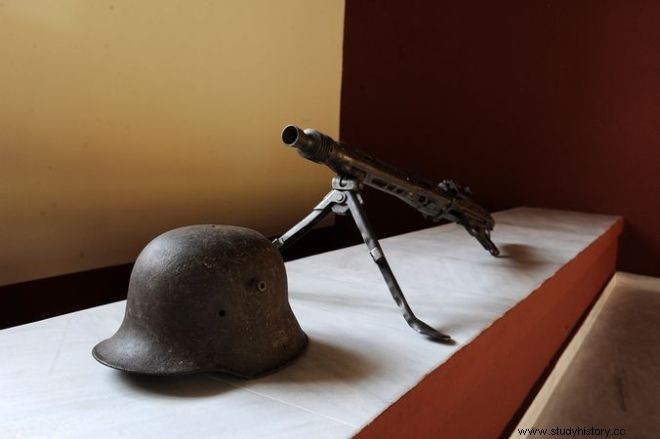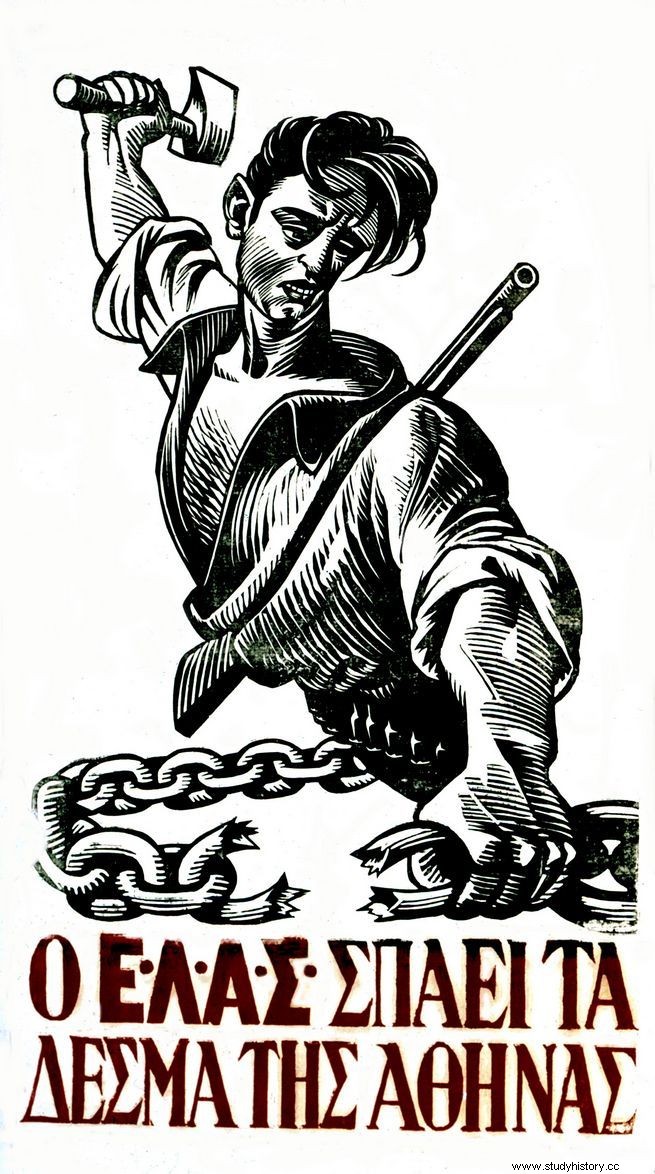The armed Resistance in Europe emerged as a result of the violent collapse of European states and the vital need for societies to react to Axis policies that threatened to dispossess or even annihilate them. In several cases, the result of the Resistance was secession from the body of Hitler's "New Europe" and the resistance movements were faced with the challenge of administering liberated areas before the end of the war.
The political forces of the resistance movements - and very characteristically the communist parties - planned a political program for the post-war period. No intention of returning to the status quo ante bellum existed here. On the contrary, there was a strong belief in the emergence of a new era of radical social change, in the form of deep reforms or even revolutionary change.
These beliefs were not only based on political programs but also on the reality of liberated areas, such as in Yugoslavia, Albania and Greece where partisan movements established their own governments in the form of National Liberation Committees.
In Greece, ELAS was created as the army of Free Greece, a territory equal to 1/3 of the country, and later the Political Committee for National Liberation (PEEA), the well-known mountain government.
When the Greek army capitulated in April 1941, there were 4,390 active duty permanent officers and approximately 8,700 reservists who were demobilized by the occupying forces. For those who did not want to serve the dosiligo regime, the solution was to go to the Middle East and enlist in the Royal Hellenic Army of the Middle East (VESMA).
Apart from the two official centers of power (Athens and Cairo), a third pole began to form, that of the Resistance, which was formed through revolutionary movements in the countryside and cities, militant claims and the creation of spaces outside of control and exploitation of the state and the conquerors. This process, combined with the political formation and action of the EAM, reached in the spring of 1943 the creation of a truly "third pole".
From a small guerrilla group, an army of 30000 men
On February 16, 1942, the days when dozens were dying of hunger in the streets of Athens, the Greek Resistance, still a pioneer, took the big step towards history. On that day, the establishment of the Hellenic People's Liberation Army (ELAS) was announced. No one knew then, nor did they imagine the extent of the phenomenon.
The political initiative for armed confrontation with the conquerors was embraced en masse by the rural Greek people who were looking for a way to protect their lives and livelihoods from the plunder of the conquerors and the dodgy government. It took a year or so for the incredible phenomenon of the liberation of most of the mainland by its own people to begin, mid-war, in Nazi New Europe.
The rural society, faced with the predatory moods of the dossier regime and the Italian Army of Occupation, was ready to resist and preserve its production. From the spring of 1942, when Aris Velouhiotis took over for the KKE the organization of an armed group in Fthiotida, until the summer of 1943, when ELAS became an army of 30,000 men, the developments were stormy.
The peasantry, through ELAS, successfully countered the attempts of the conquerors and their local collaborators to confiscate much of the harvest and control the Greek countryside. ELAS, after neutralizing the gendarmerie stations and clearing the villages of traitors and informers of the conquerors, turned against the Italians who occupied most of the Greek countryside. By the fall of 1942, ELAS was successfully countering large Italian units. By the summer of 1943, ELAS had 30,000 fighters and had liberated a very large part of Greek territory, which would remain known as Free Greece.
By the early summer of 1943, ELAS was beginning its "militarization" and the planned recruitment of officers to manage its growing bulk. From July 1943 and the assumption of leadership of ELAS by Stefanos Sarafis, flanked by Aris Velouhiotis and Andreas Tzimas, it was decided in a supreme military council to organize ELAS according to the system of the regular army and to rename the headquarters, headquarters and deputy headquarters of in corresponding units (divisions, regiments, battalions) with the same local name of the Greek army. Military regulations were also established with some exceptions, as well as the uniform of the Greek army with a bicolor instead of a peliki and as a badge the coat of arms with the word ELAS above instead of a crown.

Nazis before painful surprises
In July 1943 the Allies invade Sicily and the fascist Mussolini regime collapses. On September 8, the new Italian government capitulates. In Greece, the capitulation of the Italians will mean the spread of the resistance movement in the Italian-occupied zone, in an early atmosphere of liberation, while the guerrilla groups, mainly ELAS, will be equipped with Italian weapons.
By the end of 1943, ELAS included 600 permanent and 1,250 reservists of permanent officers, and a large number of reservists, about 2,000. These numbers represented 31% of the officers who remained in Greece and 21% of all Greek officers. Sarafis mentions in the strength of the ELAS, in September 1944 and after the Caserta Agreement, approximately 700 permanent officers, 100 permanent reservists, 1270 reservists of the ELAS School, 1500 veterans of the old army, 1070 captains and 600 officers of services called PEEA , a total of 5,240 officers.
After the Italian capitulation in 1943, the Germans realized the extent of the guerrilla movement, which until then they had consistently underestimated, and tried in a coordinated way to crush the armed Resistance and subjugate the already formed area of Free Greece. During this period, the 1st Mountain Division, the 100th, the 1st Tank Division, the 117th "Hunter" Division and other smaller units that engaged in systematic liquidation operations in Free Greece arrived in Greece. These units are charged with the most well-known war crimes (Kommeno Artas, Kalavryta, etc.), plunging the country even more into the brutality of the war, which the same units served on other fronts.
Despite the German reaction, the gradual but rapid formation of a single liberated area required a de facto form of authority. The existing issues of management and control of the space transcended local structures and led to a solution of central authority. Such creations were both the Joint General Headquarters of the Rebels in the summer of 1943 and the General Headquarters of the ELAS after the actual dissolution of the KGSA. For the same needs and making use of previous experiences, the Political Committee for National Liberation (PEEA) was formed, not only as a bargaining chip to speed up political negotiations but also as a necessary tool for managing a large, economically autonomous area, at war with its occupied surroundings .
The Insurgent Logistics (ETA) was also created which had as its main concern the supply of ELAS and the administrative mechanism of PEEA and was transformed into a financial service of Free Greece, collecting resources through a mandatory levy for the above needs but also significantly strengthening the thousands victims of the burned villages by the German liquidation operations. The National Militia was formed to relieve the fighting units of ELAS from the duties of maintaining order with the ambition to replace the old Gendarmerie with a new, more democratic body.
At the same time, the cities were groaning under the terror of the German occupiers and unfortunately the Greek Security Battalions that had been formed precisely to fight the Resistance and save "precious German blood". When in the countryside, the Greek people protected their labor, in the cities this labor became the object of the most savage exploitation. Beastly fortunes were made by those who had no qualms about exploiting their fellow citizens to death, under the protection of the Germans. Two different Greeces.

The victorious battle of the harvest
The attempt of the armed Resistance to preserve the production for the needs of the inhabitants of the more and more liberated areas and for the needs of its also increasingly larger administrative and military apparatus, became known as the "battle of the harvest". The Thessalian plain was the scene of the battle of the harvest in the form of a generalized conflict between the armies of Free Greece and that of the conquerors and their collaborators.
The fighting intensified and spread throughout the summer in a general battle, from which the resistance forces emerged strengthened, thwarting another attempt by the conquerors to dismember them by destroying their production base.
American studies conclude that German losses in occupied Greece cannot be less than 5,000 and more than 15,000, with the death rate clearly higher than usual due to the peculiarity of the war. Correspondingly, Sarafi's estimate that ELAS casualties in the operations amounted to 4,500 dead and 6,000 wounded – of which 2,000 were disabled – indicates roughly similar levels of casualties among German forces.
From glory, to the stone years via Varkiza
ELAS was a real army, based on mechanisms and institutions established in the liberation struggle, an ideal continuity between the spirit and morale of the Albanian front and a democratic reorganization of the Greek army after a long interwar period of disorder.
Phenomena of such magnitude as ELAS and the territory of Free Greece do not appear only at the will of political forces, nor are they of course the result of "rebellious" and personal initiatives. There were deep social processes rooted in the history of the place and its people, the results of a genuine revolutionary process of emerging new forms of power from the bowels of society itself.
For this reason, the dissolution of ELAS and the exclusion of its cadres and their spirit from the new army after the Liberation was the crucial issue for the British and the Greek political system and the monarchy under their auspices. And another February, that of ’45, around the same days, ELAS laid down its weapons after an agreement in Varkiza that was never kept. The people asked for the punishment of the dossiers, but it was "a lot of money" that changed hands, the gap was deep.
Stone years would follow. The result was tragic for the country and it took a cruel civil war to violently uproot the spirit of EAM and ELAS, thirty years of a society in plaster. And what was not written all this time about the Elasites, the defenders of the homeland were baptized traitors and "Bulgarians" and sent en masse to exiles, prisons and firing squads.
Even today, the spirit of ELAS is exorcised through silence and mainly through distortion. But there are now many good studies on what ELAS was and what it offered, for those who are not satisfied with the blur of the internet. Eighty years later, ELAS is rightfully in the pantheon of the most glorious moments of recent Greek history.
Yannis Skalidakis is a professor at the Department of Political Science at the University of Crete and a writer
Follow News247.gr on Google News and be the first to know all the news
